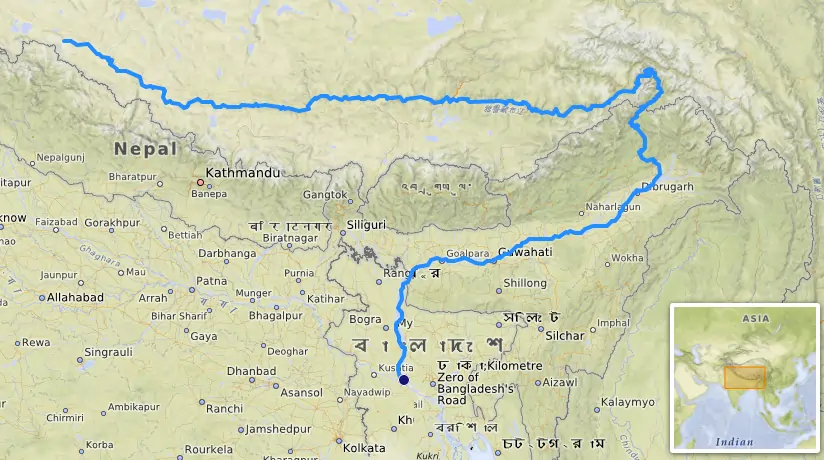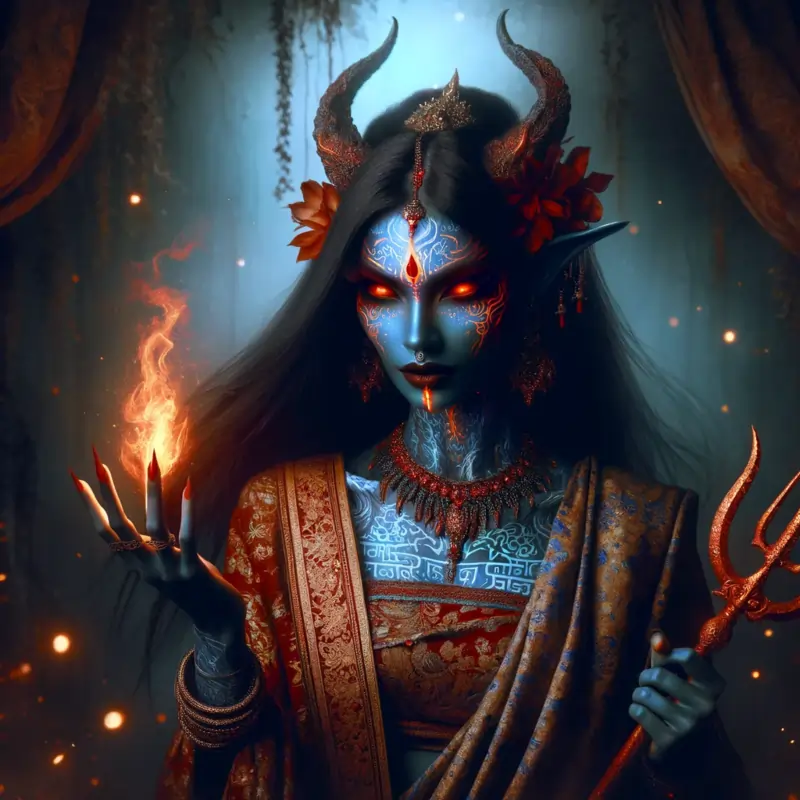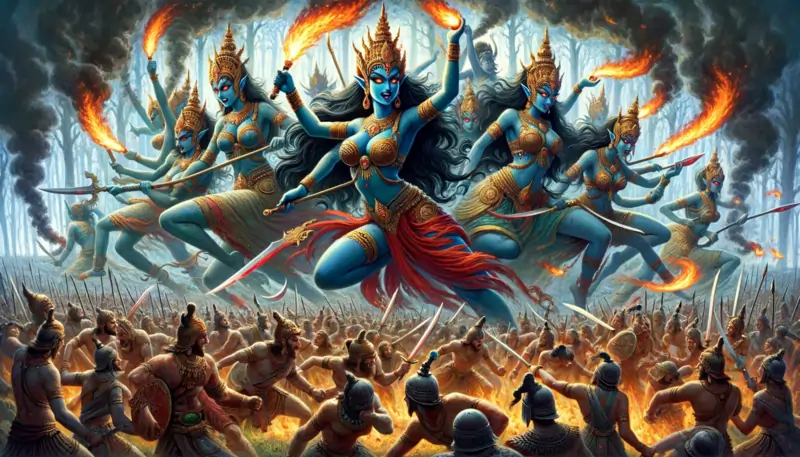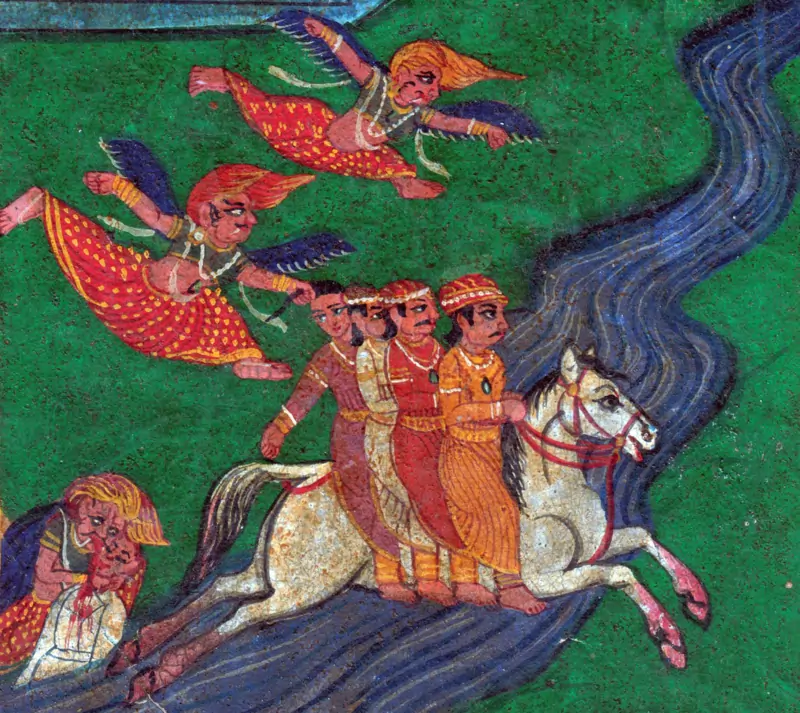Introduction: A Merchant’s Tale Becomes a Cultural Cornerstone
In the bustling streets of modern-day Thamel, Kathmandu ( See in Map) echoes a tale that transcends time – the story of Singha Sartha Bahu, or Singha Sartha Aju, also known in Newari culture as Chakan Dya (चकंद्य:). This narrative, more than just a story, is a crucial part of the Newari culture and is believed to be one of the past lives of Shakyamuni Buddha. It is believed that this story was told by Shakyamuni Buddha as one of his past incarnations. Let’s delve into this fascinating journey from the heart of Nepal to the realms of spirituality and legend.
The Merchant’s Quest Begins
Singha Sartha Bahu’s story begins in the ancient city of Singha Kalpa Nagar, now known as Tham Bahi or popularly known as Thamel, a renowned tourist spot in Kathmandu. This historic place was once part of the vast continent of JambuDvipa, with “Dvipa” denoting a continent. Born into a family of merchants, Singha Sartha Bahu was destined for trade and adventure.
Driven by the ambition to broaden the horizons of his family’s business, Singha Sartha embarked on an international trade expedition. Accompanied by a group of 500 fellow merchants, they journeyed northward, traveling with a grand caravan that included elephants, horses, and camels. Their journey took them through numerous towns and villages until they arrived at the banks of the mighty Brahmaputra River.
As they set out to cross the river, their journey took a dramatic turn. A fierce and unexpected windstorm struck, shattering the tranquility of the river. The boat, unable to withstand the ferocity of the winds, broke apart, plunging everyone into the turbulent waters. In a testament to their resolve and strength, each member of the expedition swam with all their might, battling the currents to reach the safety of the river’s opposite bank, where they encountered the Lasins, or demonesses, from TamraDvipa.

A Deceptive Paradise
Upon hearing the tumultuous sounds of the boat wreck and human voices, the Lasins, mystical demonesses from Tamradvipa, were drawn to the scene at the Brahmaputra riverbank. There, they encountered Singha Sartha and his group of 500 merchants. Employing their enchantments, the Lasins transformed themselves into captivating young women, appearing as 16-year-old maidens, to attract the merchants. Approaching them with a guise of innocence, they claimed to be beautiful inhabitants of Rantapur Nagar, using their allure and physical charm to draw the merchants towards their dwelling.

The Lasins hosted the merchants with great hospitality, lavishing them with luxurious gold jewelry, a variety of drinks, and continuous entertainment, effectively indulging their senses day and night. This extravagant treatment continued for a week, during which time the merchants were so enraptured that they nearly lost all memory of their original journey and families.
However, the situation took a dramatic turn when Lord Karunamaya, the Bodhisattva of Compassion, appeared in the flame of a lamp in Singha Sartha’s room. He revealed the shocking truth to Singha Sartha – these seemingly beautiful women were, in fact, man-eating Lasins in disguise. Upon hearing this revelation from Karunamaya, Singha Sartha resolved to escape their clutches and return to his homeland.
The Great Escape and Tragic Loss
The following day, Singha Sartha and his 500 merchants made their decisive move to return home. Upon reaching the banks of the Brahmaputra River, they encountered a king of horses named Barah. Singha Sartha sought Barah’s assistance in crossing the river and escaping the Lasins. The horse agreed to help, with one critical condition: they must follow his instructions precisely. He instructed that once they were on his back, they must keep their eyes closed, refrain from looking back, and continuously recite the TriRatna, the Triple Gem mantra.
Mounting Barah, Singha Sartha Bahu and the merchants took to the skies, soaring at wind-like speeds amidst thunderous roars. The Lasins, upon hearing this, gave chase, attempting to lure the merchants back with memories of the time spent in Ranapur Nagar. Despite the warnings, emotions overpowered some of the merchants who looked back, only to be captured and devoured by the pursuing Lasins. Amidst this chaos, Singha Sartha Bahu remained steadfast, his eyes closed and his lips murmuring the TriRatna mantra. Ultimately, he was the sole survivor to reach Singha Kalpa Nagar.
The tragic loss of the other merchants plunged Singha Sartha Bahu into deep grief. In this moment of sorrow, Lord Karunamaya consoled him from the heavens, bestowing upon him the Chandrahas sword and foretelling his future as the ruler of Singha Kalpa Nagar.
The Lasin’s Revenge and a Rise to Kingship
In a twist of events, the chief Lasin, harboring a grudge against Singha Sartha Bahu for eluding her grasp, concocted a plan for revenge. She transformed herself into a stunning woman and made her way to the city of Singha Kalpa Nagar with the intent of ensnaring Singha Sartha Bahu. Initially, she claimed to be his abandoned wife from Ratnapur Nagar and even fabricated a child, alleging it to be theirs, in a bid to gain sympathy and support from the city’s inhabitants and eventually from King Singha Kesar himself.
Summoned by the King, Singha Sartha Bahu was confronted with the supposed wife. The King, beguiled by the chief Lasin’s beauty, presented Singha Sartha with an ultimatum: reclaim his wife or the King would take her for himself. Singha Sartha Bahu, aware of her true demonic nature, refused to accept her. Consequently, the King, captivated by her allure, decided to keep her in the palace.
In a darker turn, the chief Lasin seizing an opportunity, summons her fellow Lasins from Tamradvipa. In a sinister plot, they assassinate the King and his palace staff, and eat them all.
Following this upheaval, the kingdom of Singha Kalpa Nagar faced a power vacuum. In light of his wisdom and the respect he commanded, the citizens unanimously chose Singha Sartha Bahu to ascend the throne as their new king.
The Battle for Redemption
Upon ascending to the throne, King Singha Sartha Bahu took a decisive stance against the Lasins of Rantapur Nagar, declaring war to confront the threat they posed. Leading his army into battle, King Singha Sartha engaged in fierce combat with the Lasins. In the midst of this conflict, he wielded the Chandrahas Sword, a powerful gift from Lord Karunamaya.

The battle reached a critical point where the Lasins, overwhelmed by the might of King Singha Sartha and his army, ceased their aggression and sought mercy. In response, King Singha Sartha Bahu, while expressing his inability to forgive them as a king, offered them a chance for redemption. He proposed that their lives would be spared on the condition that they abandon Ratnapur Nagar, vow never to consume human flesh again, and retreat to a distant jungle.
The Lasins, recognizing the gravity of the situation, agreed to these terms. They left Ratnapur Nagar, renouncing their former practices, and retreated into the wilderness. Subsequently, King Singha Sartha Bahu renamed TamraDvipa to SinghalDvipa as a symbol of this new era of peace and returned to Singha Kalpa Nagar, ushering in a period of stability and prosperity under his rule.
A Legacy of Faith and Celebration
In a gesture of reverence and gratitude to Lord Karunamaya, King Singha Sartha Bahu introduced a tradition of fasting on Astami. This practice was more than just a personal act of devotion; it symbolized his deep spiritual connection and his commitment to the values of compassion and wisdom that Lord Karunamaya represented. Singha Sartha Bahu’s life and deeds elevated him to a revered status in Newar Buddhism culture, where he is venerated as a previous incarnation of Shakyamuni Buddha.
Even today, the legacy of Singha Sartha Bahu continues to resonate strongly within the cultural and spiritual fabric of Nepal. His statue is worshipped as Chakan Dya – चकंद्य:, a respected deity, at Bhagwan Bahal (Bikramshil Mahavihar) in Thamel, Kathmandu ( See in Map). This enduring reverence is a testament to the profound impact of his life and the values he stood for.

Every year, a grand celebration takes place, imbuing the city with a sense of historical pride and spiritual continuity. On the full moon day of March, a festival is held in his honor, where the effigy of Chakan Dya is carried throughout the city. This event coincides with the vibrant and colorful Hindu festival of Holi, creating a confluence of cultural and religious celebrations. The festival not only commemorates the remarkable journey of Singha Sartha Bahu but also symbolizes the fusion of various facets of Nepalese heritage, showcasing the rich tapestry of myths, legends, and traditions that shape Nepal’s identity.
Frequently Asked Questions
- Who was Singha Sartha Bahu?
Singha Sartha Bahu was a legendary figure from the ancient city of Singha Kalpa Nagar, now known as Thamel in Kathmandu. He was a merchant destined for adventure and trade. - What is the significance of Singha Kalpa Nagar in the story?
Singha Kalpa Nagar, the birthplace of Singha Sartha Bahu, was part of the historic Singha Kalpa Nagar of the JambuDvipa continent. Today, it is a famous tourist spot in Kathmandu, known as Tham Bahi, or popularly known as Thamel, known for its rich history. - What led Singha Sartha Bahu to embark on his journey?
Motivated by the desire to expand his family business, Singha Sartha Bahu organized an international trade expedition with 500 merchants, traveling northward with a grand caravan. - What challenges did Singha Sartha Bahu face during his journey?
The journey took a dramatic turn at the Brahmaputra River, where a violent windstorm broke their boat, forcing the entire party to swim to safety, only to encounter the Lasins or demonesses. - Who were the Lasins in the story?
The Lasins were mystical demonesses from Tamradvipa who used enchantment to disguise themselves as young women, luring the merchants with their charm and hospitality. - How did Singha Sartha Bahu escape the Lasins?
Alerted by Lord Karunamaya about the Lasins’ true nature, Singha Sartha Bahu and his merchants fled on the back of a mystical horse, Barah, while reciting the Triple Gem mantra. - What was the fate of the merchants who accompanied Singha Sartha Bahu?
Tragically, all merchants except Singha Sartha Bahu were captured and eaten by the Lasins, as they looked back despite being warned not to. - How did Singha Sartha Bahu become the king of Singha Kalpa Nagar?
After a series of events involving Chief Lasin’s deception, chief Lasin kills and eats the King and the entire palace staff. This event led the citizens to unanimously choose Singha Sartha Bahu as their new ruler. - What was the outcome of the battle against the Lasins? King Singha Sartha Bahu, wielding the Chandrahas Sword, fought the Lasins. Eventually, the Lasins sought forgiveness and agreed to leave Ratnapur Nagar, vowing never to harm humans again.
- How is Singha Sartha Bahu honored today? Singha Sartha Bahu is venerated as a previous incarnation of Shakyamuni Buddha in Newar Buddhism. His statue, known as Chakan Dya, is worshipped in Thamel, Kathmandu. An annual celebration, coinciding with the Holi festival, is held in his honor.
- How is Singha Sartha Bahu related to Kesh Chandra from Itumbahal?
Kesh Chandra’s sister is married to Singha Sartha Bahu from Tham Bahi. This makes Kesh Chandra the brother-in-law of Singha Sartha Bahu. Kesh Chandra is from Itumbahal related to the famous story of Gurumapa.
References
- Singha Sartha Bahu, the Merchant of Singha Kalpa Nagar, Kamal Ratna Tuladhar, 2014
- Brahmaputra River, Wikipedia.org
- JambuDvipa, Wikipedia.org
- Singha Sartha Aju, Wikipedia.org

